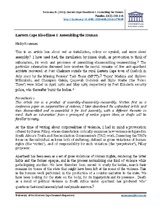| dc.contributor.author | Rousseau, Nicky | |
| dc.date.accessioned | 2018-06-22T09:34:43Z | |
| dc.date.available | 2018-06-22T09:34:43Z | |
| dc.date.issued | 2016 | |
| dc.identifier.citation | Rousseau, N. (2016). Eastern Cape Bloodlines I: Assembling the Human. Parallax, 22(2): 203-218. | en_US |
| dc.identifier.issn | 1353-4645 | |
| dc.identifier.uri | http://dx.doi.org/10.1080/13534645.2016.1175069 | |
| dc.identifier.uri | http://hdl.handle.net/10566/3826 | |
| dc.description.abstract | This is an article less about red as installation, colour or symbol, and more
about assembly.1 I have used Red, the installation by Simon Gush, as provocation
to think of exhumation, its work and processes of assembling–disassembling–
reassembling.2 The particular exhumation discussed here involves the
mortal remains of five anti-apartheid activists recovered at Post Chalmers
outside the rural Eastern Cape town of Cradock in July 2007 by the Missing
Persons’ Task Team (MPTT).3 ‘Topsy’ Madaka and Siphiwo Mthimkulu, and
Champion Galela, Qaqawuli Godolozi and Sipho Hashe (the ‘Pebco Three’)
were killed in April 1982 and May 1985 respectively by Port Elizabeth security
police, who thereafter burnt the bodies.4 | en_US |
| dc.language.iso | en | en_US |
| dc.publisher | Taylor & Francis | en_US |
| dc.rights | This is the author-version of the article published online at:
http://dx.doi.org/10.1080/13534645.2016.1175069 | |
| dc.subject | Assembly | en_US |
| dc.subject | Missing Persons Task Team | en_US |
| dc.subject | Pebco Three | en_US |
| dc.subject | Exhumation | en_US |
| dc.title | Eastern Cape Bloodlines I: Assembling the Human | en_US |
| dc.type | Article | en_US |
| dc.privacy.showsubmitter | FALSE | |
| dc.status.ispeerreviewed | TRUE | |
| dc.description.accreditation | IBSS | |

